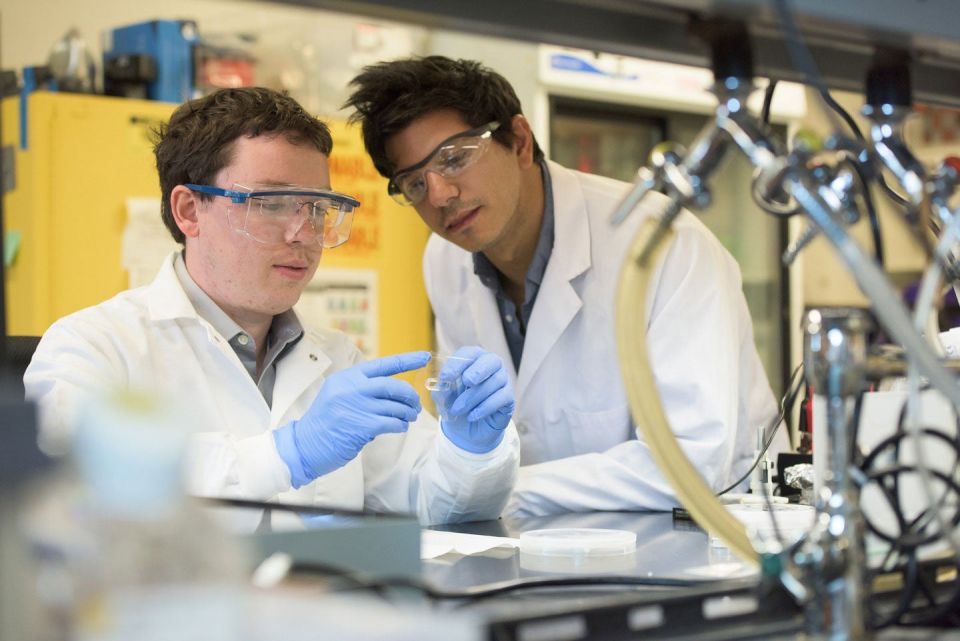When asked for the biggest idea that would transform neuroscience, Stanford materials science engineer Nicholas Melosh came up with this: using engineering tools he and his colleagues were developing to record the electrical activity of cells.

Stanford researchers Greg Pitner and Matt Abramian finalize sample preparation in the Neurofab, mounting the cell culture vessel to the suspended wafer. (Image credit: L.A. Cicero)
If it works, Melosh’s big idea could help neuroscientists improve on devices that interface with the brain – such as those currently used to relieve symptoms of Parkinson’s disease – screen drugs for electrophysiology side effects, and understand with greater precision the electrical currents that underlie our thoughts, behaviors and memories.
To make this idea a reality, Melosh, an associate professor of materials science, engineering and photon science, founded the NeuroFab as an initiative of the Stanford Neurosciences Institute. It was one of seven interdisciplinary “Big Ideas” initiatives intended to tackle fundamental problems in neuroscience.
“Eventually we’d like to create a toolset that would impact many neuroscience labs,” he said.
Building a bridge
The NeuroFab serves as both a physical space where engineers and neuroscientists can collaborate on new tools and an intellectual space with regular meetings to discuss ideas.
Melosh said neuroscience and engineering have a lot in common.
“Neural activity is electrical in nature and is a natural fit for engineers,” he said. But the language, cultures and skills of the two groups have been hard to bridge.
John Huguenard is one of the neuroscientists on the other side of that bridge.
“There is a cultural difference between engineers and biologists,” said Huguenard, a Stanford professor of neurology and neurological sciences.
“When they start talking about device characteristics, it is lost on us. Similarly, when we say there are different types of neurons with very different properties, it’s lost on them.”
Huguenard studies widespread neural activity in the brain, such as what occurs in sleep patterns or epilepsy.
“This work requires us to record from many parts of the brain simultaneously,” he said, something that has been challenging with existing technology.
Currently, neuroscientists have two primary methods to record cellular electrical activity. One is highly accurate, but can only record from one cell at a time, inevitably killing the cell within about two hours. The other can record long-term from an array of cells, but is not very sensitive.
So far, teams within the NeuroFab are experimenting with a variety of approaches for reading electrical signals. Two of the more well-developed ones involve conductive nanomaterials, either in the form of nanopillars, which poke up into cells from below, or arrays of linear nanotubes that pass through cells like a bead on a string.
Other approaches involve the optical recording of electrical fields, massively parallel interfaces based on computer chips, and membrane-fusing electrodes.
Nanotubes
Early in the NeuroFab’s existence, Melosh started talking with Philip Wong, a Stanford professor of electrical engineering, whose lab is developing ways of using highly conductive carbon nanotubes for next-generation computer chips. Wong brought in graduate student Gregory Pitner, who had experience with techniques for making those carbon nanotubes in a variety of configurations.
“We grow them aligned, we grow them dense, we grow them consistently and reproducibly,” Pitner said, who believes that the dense, aligned nanotubes could provide a conductive surface for cells to grow on.
That initial design changed when Pitner got a lesson in cell biology from Matthew Abramian, a postdoctoral fellow in Huguenard’s lab.
Cells, Abramian explained, are surrounded by a halo of sugars and proteins and it’s these molecules that are in contact with a lab dish, not the cell itself. To get access to electrical changes within the cell, Pitner learned that his nanotubes needed to be suspended in a way that would allow the cell to encompass and incorporate the tube.
“There are all sorts of practical details to understand about cell behavior that go way beyond high school biology,” Pitner said.
The new design has small troughs for the cells to grow in, containing a single nanotube leading out to a recording station. With that new design, the pair needed to find that right cell type to test whether the idea works.
If it succeeds, they envision being able to record from any kind of conductive cell including different types of neurons or heart muscle.
“This would be a device where you can get data on hundreds of neurons at one time,” Abramian said.
Cultural surprises
Abramian said the pace of biology came as a surprise to engineers.
“Engineers just think we’ll grow some cells and the next day we’re going to record,” he said. “That’s not how it works at all.”
Cells can take up to weeks to grow, and then they don’t always have the anticipated properties, he added.
By contrast, Abramian said he was amazed by the amount of control engineers have over their designs.
“They have methods for building really intricate devices, and they can test them right away,” he said.
By including faculty and students from many disciplines, Pitner said, the NeuroFab helps bridge these gaps in knowledge and expertise.
“These kinds of relationships are almost impossible to create in a vacuum,” he said.
Melosh said he hopes tools developed in the NeuroFab will enable bidirectional communication with neurons in a dish, and eventually the brain, which may start to unlock secrets of the brain by measuring from many places at once.
Nicholas Melosh is also a member of Stanford Bio-X, the Child Health Research Institute, the Precourt Institute for Energy and Stanford ChEM-H. John Huguenard is also professor by courtesy of molecular and cellular physiology and neurosurgery and is a member of Stanford Bio-X and the Child Health Research Institute. Philip Wong is also Willard R. and Inez Kerr Bell Professor in the School of Engineering and is a member of Stanford Bio-X and the Precourt Institute for Energy.
Media Contacts
Amy Adams, University Communications: (650) 497-5908, amyadams@stanford.edu
Clifton B. Parker, Stanford News Service: (650) 725-0224, cbparker@stanford.edu